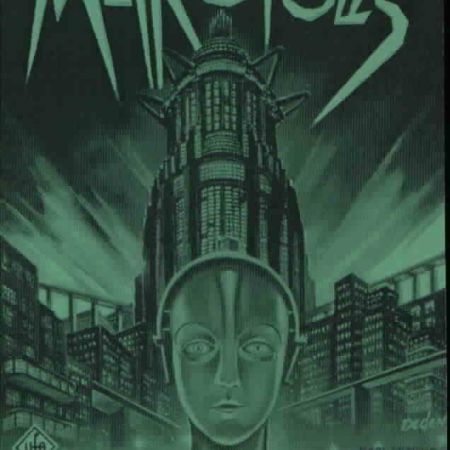Fritz Lang (Dec. 5, 1890 - Aug. 2, 1976), Austrian-American film director, was born in Vienna, the son of an architect, Anton Lang, and Paula Schlesinger Lang. Working first in Berlin during the silent-film era of the 1920's, and later in Hollywood, Lang used cinema to explore a personal fascination with, in his words, "cruelty, fear, horror and death." His film-making style is characterized by grandeur of scale, striking visual compositions and sound effects, suspense and narrative economy -- including the minimalist techniques for enlisting the audience's imagination to evoke horror. A progenitor of the film noir of the 1960's, Lang was preoccupied throughout his oeuvre with the dark side of human nature: vengeance, violence, and the criminal mind. His heroes are brought down by injustice, bad women, or the iron laws of fate.

As a youth, Lang studied architecture for a while at the Technische Hochschule (Technical High School) in Vienna. At age 20 he left home and travelled throughout the world, including North Africa, Asia Minor, Russia, China, Japan, and the Pacific, support- ing himself by selling drawings, painted postcards, and cartoons. In 1913 he settled in Paris in order to paint, and he had an exhibition there in 1914. At the outbreak of World War I, Lang returned to Vienna and was conscripted into the Austrian Army. Wounded four times, he was discharged as a lieutenant and began writing screenplays while convalescing for a year in a Vienna hospital.
After the war Lang worked in Berlin with the producer Erich Pommer, as a script reader, writer, and eventually director of films for the Decla Bioscop Company, before forming his own film production concern. His directorial debut was "Halbblut" ("The Half-breed") in 1919, the first of many Lang films in which a man is destroyed by his love for a woman; in 1920 he married popular writer Thea von Harbou, who collaborated on his German screenplays.
Lang's first successful effort was "Der mde Tod" ("The Tired Death," 1921, released in the U.S. as "Between Two Worlds"), which inspired Douglas Fairbanks Sr.'s 1924 feature, "The Thief of Baghdad." It was followed by "Dr. Mabuse, Der Spieler" (1922), a two-part portrait of a master criminal, and "Die Niebelungen" (1924), released in the United States in two parts, "Siegfried" and "Kriemhild's Revenge," based on the 13th-century Siegfried epic, and intended to restore pride in Germany's cultural heritage.
"Metropolis" (1926), a powerful expressionistic drama about a futuristic slave society, was a stunning technical achievement; despite its simplistic message it remains a classic. The production nearly bankrupted the UFA studio, and Lang formed his own production company. His next masterpiece was "M" (1931), starring Peter Lorre as a compulsive child-murderer. "M" was also the first German sound film and is still considered by critics and audiences alike to be the acknowledged masterpiece of Lang's German period, and was his personal favorite.
But Lang was more or less an opponent of the Nazis. Even if he wasn't Jewish, he used a madman in an asylum to espouse Nazi doctrines in the 1932 film "Das Testament des Dr. Mabuse" ("The Last Will of Dr. Mabuse"). After it opened, he was summoned by Joseph Goebbels, Hitler's Propaganda Minister, and invited to supervise Nazi film production. Instead, Lang fled Germany for Paris the same day, leaving behind a personal fortune and a vast collection of primitive art. In 1933, Thea von Harbou divorced him, and joined the Nazi movement. After making one film in France in 1934 ("Liliom," starring Charles Boyer), Lang signed a one- picture contract with David O. Selznick of Metro-Goldwyn-Mayer and moved to Hollywood, where for the next twenty years he worked in such various genres as thrillers, war and crime dramas, and Westerns.
Although naturalized in 1935 as a United States citizen, Lang retained for some years his monocle and a Continental formality of bearing. But he developed a strong penchant for the American West -- living for weeks at a time on Indian reservations -- and for American slang. His Hollywood debut, "Fury" (1936), a study of mob violence starring Spencer Tracy and Sylvia Sidney, was a huge commercial and critical success. It was followed by "You Only Live Once" (1937); "You and Me" (1938); two Westerns for the Twentieth Century-Fox studio, "The Return of Frank James" (1940), and Western Union" (1941); and a series of war films, thrillers and melodramas, including "Hangmen Also Die" (1943), which Lang wrote in collaboration with Berthold Brecht; "The Ministry of Fear" (1944); and "The Woman in the Window" (1944) and "Scarlet Street" (1945), both starring Edward G. Robinson. The later films, mostly crime dramas, included Clifford Odets's "Clash By Night" and "Rancho Notorious," a Western starring Marlene Dietrich, in 1952; "The Big Heat" and "The Blue Gardenia" (1953); Human Desire (1954); "Moonfleet" (1955), a costume drama; "Beyond a Reasonable Doubt" (1956); and "While the City Sleeps" (1956).

A tall, physically imposing figure, and a perfectionist by nature, Lang could be a temperamental and dictatorial presence on the set. His differences with producers ultimately prompted his departure from Hollywood in 1956. He directed two low-budget films in India, and in 1959 returned to Germany, where he directed his final film, "The Thousand Eyes of Dr. Mabuse," in 1960. In 1963 he portrayed himself in the film "Mopris" by Jean-Luc Godard, released in the United States as "Contempt." Lang was awarded the French Officier d'Art et des Lettres. He died in Beverly Hills, California on Aug. 2, 1976, at the age of 85.

































